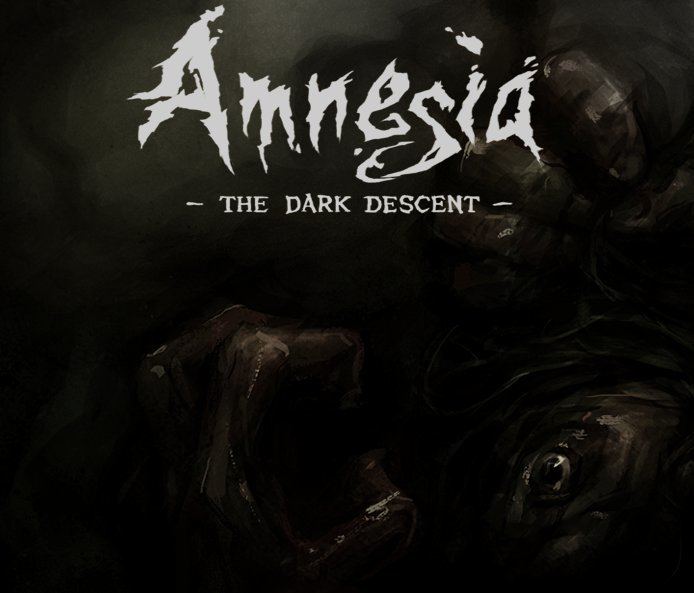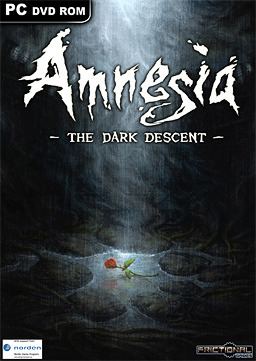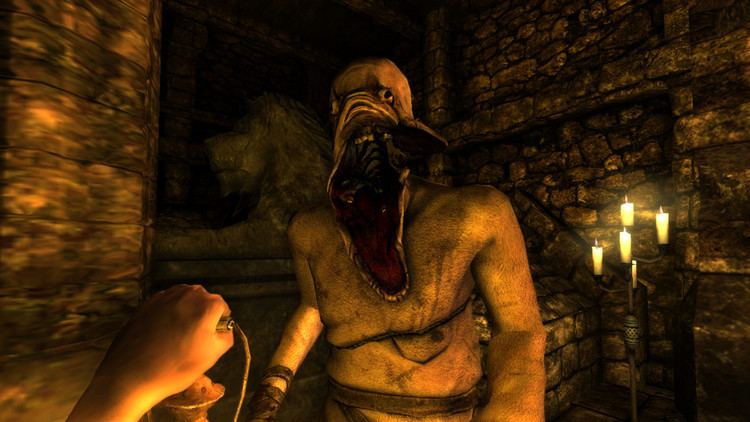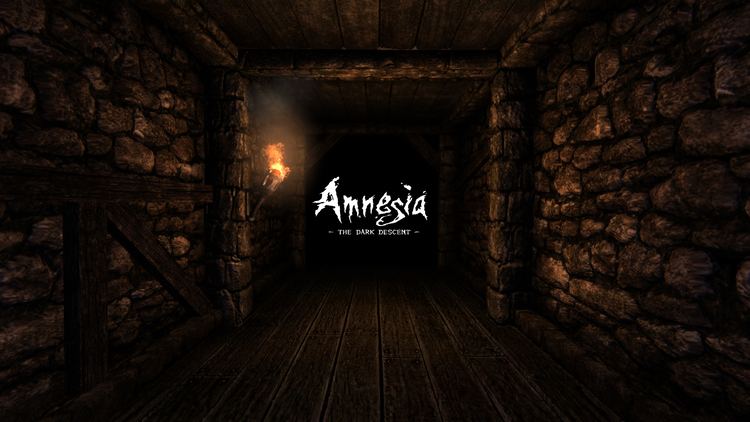9 /10 1 Votes
8.5/10 GameSpot Writer(s) Mikael Hedberg Series Amnesia Initial release date 8 September 2010 Genre Survival horror | 10/10 Steam 8.5/10 IGN Designer Thomas Grip | |||||||||||||||||||||||||||||||||
 | ||||||||||||||||||||||||||||||||||
Programmer(s) Thomas GripLuis Rodero Morales Similar Amnesia games, Frictional games, Survival horror games | ||||||||||||||||||||||||||||||||||
Amnesia the dark descent walkthrough part 3 scary let s play gameplay commentary
Amnesia: The Dark Descent is a survival horror video game by Frictional Games, released for Microsoft Windows, Mac OS X, Linux and PlayStation 4 platforms. The game features a protagonist named Daniel exploring a dark and foreboding castle, while avoiding monsters and other obstructions as well as solving puzzles. The game was critically well received, earning two awards from the Independent Games Festival and numerous positive reviews.
Contents
- Amnesia the dark descent walkthrough part 3 scary let s play gameplay commentary
- Amnesia the dark descent trailer
- Gameplay
- Plot
- Amnesia Justine downloadable content
- Development
- Audio
- Downloadable content
- Custom stories
- Reception
- Sequel
- References

Originally released independently via online distribution, the game has since been published in retail by 1C Company in Russia and Eastern Europe, as well as THQ in North America. A collection of five short stories set in the world of Amnesia, written by Mikael Hedberg and illustrated by the game's concept artists, was also made available. In addition, the game's soundtrack is available for purchase and a free content expansion Justine has been released as well as many fan-made expansions and stories for its unique "Custom Story" gamemode. The Amnesia Collection – which contains The Dark Descent, its Amnesia: Justine expansion and the sequel, A Machine for Pigs – was released for PlayStation 4 on November 22, 2016.

Amnesia the dark descent trailer
Gameplay

In a similar vein to the developer Frictional Games' previous games, Amnesia is an adventure game played from a first-person perspective. The game retains the physical object interaction used in the Penumbra series, allowing for physics-based puzzles and interactions such as opening doors and fixing machinery. Few in-game objects are operated by toggle; to open a door, for instance, the player must hold down a mouse button and then push (or pull) the mouse. This gives the player stealth, allowing them to peek out a barely-opened door or open it slowly to sneak away, but also adds to the player's sense of helplessness, as it is now entirely possible to attempt to push open a "pull" door whilst danger approaches from behind.

In addition to a health indicator, Daniel's sanity must be managed. Being in darkness too long, witnessing unsettling events, or staring at monsters will reduce Daniel's sanity, causing visual and auditory hallucinations and drawing the attention of monsters. Light sources help restore sanity, and if none are available Daniel may use tinderboxes to ignite candles in wall sconces and candelabra, or deploy an oil-burning lantern found near the beginning of the game. However, the number of tinderboxes and the amount of oil available are both limited, and standing in a light source also makes the player more noticeable to monsters. The player must balance the amount of time Daniel spends in light and shadow. Sanity is fully restored once Daniel completes an objective or progresses the game's story. It may also be restored by staying in the shadows until Daniel passes out, but this leaves him extremely vulnerable to any nearby monsters.

If a monster spots Daniel, it will chase him until he's out of sight. If spotted, Daniel must flee, as Amnesia does not give the player access to weapons. Daniel must find hiding places or barricade doors with rocks, chairs and other obstacles; however, monsters are capable of tearing down doors in their path and kicking obstacles out of the way, and move extremely fast once they have spotted their prey. Players can also choose to hide Daniel in the shadows, at cost to sanity. Monsters who lose sight of Daniel will search for him for a time, but will eventually leave and vanish. They can also choose, preferably while being chased, to pick up an object and throw it to the monster, temporarily stunning the monster for about two seconds and giving Daniel some extra distance.
Plot

In late August 1839, Daniel, a young man from London, awakens in the dark and empty halls of the Prussian Brennenburg Castle with little to no memory about himself or his past. All he can remember is his name, that he lives in Mayfair and that something is hunting him. He has a note written to himself, which informs him that he has deliberately erased his own memory and is being hunted by a "shadow", and instructs him to descend into the Inner Sanctum of the castle in order to find and kill its baron, Alexander. As he makes his way through the castle, Daniel gradually learns both about its mysteries and about his own past, through notes and diaries he finds as well as through sudden flashbacks and visions. He also finds himself followed by an unearthly presence – the Shadow – manifesting itself through fleshy, acidic growths spreading through the castle, and encounters terrifying creatures known as "gatherers", formerly human monsters from whom he must hide or flee.
Daniel collects his own diaries which reveal that in May, he had gone on an archaeological expedition with a professor Herbert, who sought to excavate the tomb of Tin Hinan, buried in the Algerian desert. Separated from his men in the tomb, Daniel discovered a mystical orb and felt it calling to him, entering into trance when he held it. Afterwards, Herbert sent him back to London to recover and he brought the orb with him. Engrossed in its other-worldly quality, he consulted books and educated men about the orb's nature, finding that others have been known to exist, and wrote letters to people from Herbert's address book. He began to be plagued by nightmares, and found that Herbert's expedition has disappeared and the men he had recently consulted have suffered horrible deaths. Feeling desperate and hunted, he decided to accept the invitation of Alexander, who had replied to his letter by offering him protection at Brennenburg. After his arrival, the baron told him that he is being followed by the orb's "shadow" or "guardian", which will kill anything in its path to reclaim the orb, and that he should use the orb's power to fight back. Deep in the castle, he instructed Daniel in rituals supposedly serving to at least temporarily banish the Shadow, which included the killing and torture of imprisoned people, supposedly dangerous criminals. When they kidnapped the children of a farmer for what Alexander said would be the final banishment ritual, and Daniel killed one of the girls as she attempted to flee, he lost faith in Alexander, who left him for dead and descended into the Inner Sanctum alone with the orb. Broken, he decided to kill Alexander in revenge for making him a monster, and wiped his memory with an "amnesia" potion.
It is revealed that Alexander is not human, but rather a being from another dimension who arrived on Earth several centuries ago, establishing himself in Brennenburg under the guise of a human baron and constantly prolonging his life with "vitae", a substance harvested by torturing humans, whom he has been hunting for this purpose. He has been seeking a way to use an orb to return to his dimension, and now needs to do this as soon a possible since he fears that other nobles no longer trust him. As Daniel nears the Inner Sanctum, he encounters Heinrich Cornelius Agrippa, a man who had once studied the orbs with his student Johann Weyer and has since been kept alive and imprisoned by Alexander. He tells Daniel that Weyer has been able to harness the power of the orbs to travel between dimensions, which Alexander is preparing to do right now, and instructs him in finding the pieces of what used to be his own orb, which is needed to breach the Inner Sanctum. Agrippa also asks Daniel to take with him his head, which can be severed alive using a tonic invented by Weyer, and throw it into the inter-dimensional portal after Alexander opens it. Once Daniel enters the Inner Sanctum, there are three possible endings: he can let Alexander succeed, then be killed by the Shadow and descend into darkness, while Alexander tells him his sacrifice will be forever celebrated; he can prevent the portal from opening, then leave the castle content with his redemption after the Shadow kills only Alexander; or he can throw Agrippa's head into the portal, which leaves the Shadow to kill both Alexander and Daniel, though Agrippa promises to save Daniel from descending into darkness, calling upon Weyer to help him and stating that "it will be alright".
Amnesia: Justine downloadable content
The player takes control of an unnamed female character, who awakens with amnesia in a dungeon cell, accompanied only by a phonograph. This phonograph contains a recording by a woman named Justine, who tells the player character that she is the subject of a psychological test. The player character is then allowed to escape, or die trying.
The player character is presented with several puzzles to solve. In each, she has the option of simply abandoning the puzzle and walking away, but doing so will cause an innocent victim contained within (a doctor, a priest and a policeman) to die. She is also stalked by the Suitors, three monstrous characters whom Justine (through additional phonographs) reveals to be her own former paramours, now twisted by physical and psychological torture. The player character may also collect notes scattered throughout the testing environs, which give additional background information on the Suitors and Justine herself.
The game's exact ending depends on how many puzzles the player has chosen to solve, and thus how many victims survived. However, all of them proceed along roughly the same lines: after surviving the puzzle sections, the nameless female discovers a phonograph dangling from the ceiling, which causes the walls of the chamber to begin moving inward as though to squash the protagonist. She passes out, but awakens unharmed and begins to congratulate herself. The protagonist is Justine, who staged the entire experiment to see if she still had any compassion for humanity within herself. Armed with her new-found knowledge, she moves forward into the ending sequence, in which any surviving victims thank her (not realizing she does not intend to free them now that her memory is restored) and, if none were saved, the Suitors, trapped, shout threats upon her; it is also possible to change Justine's final lines if a hidden document is found in the Library. Then she goes upstairs back to her house to prepare herself to attend her guests for a imminent party.
Development
Work began on the game while Penumbra: Requiem was still being developed, with the company working on both projects at the same time. The game was first known under two working titles: Unknown and Lux Tenebras. It was not until November 13, 2009 that it was announced as its current title, Amnesia, with the release of the game's website and a game trailer. Initial designs of the game varied considerably from the final game, with the developers interested in reintroducing more combat elements similar to those utilized in their first commercial title Penumbra: Overture. The developers soon discovered that they encountered many of the same problems and difficulties that plagued the combat in that game however, and the design was further changed to be more similar to the style set out by Overture's sequel Penumbra: Black Plague.
On February 5, 2010 it was announced that the game had reached the alpha stage of development on all platforms. Two weeks later the developers released a new teaser trailer that showed actual game-play footage, and the developers began accepting pre-orders for the game through their website. Also revealed was that the game was at that point being tested on all three intended platforms. It was also announced that the game would be released simultaneously for all of them in August 2010. This was later rescheduled, and the game was then expected to have a September 8, 2010 release. It was then later announced on August 27, 2010 that the game had officially gone Gold and would soon be ready to sold. On September 3, the games demo was released containing selected parts of the gameplay and story. It was then successfully released on September 8, 2010.
If the game reached 2000 pre-orders by May 31, 2010, Frictional promised it would release extra content for the game. The goal was finally met in early May, after the pre-orders were offered at a discount made available until May 31. This was done due to the success of Penumbra: Overture as a part of the first Humble Indie Bundle. The extra content was revealed to be commentary, and they explained in the comments section of the same page that its intended function was similar to that of Valve Corporation's commentary system that began in the Half-Life 2 series. The authors cite "Soul Made Flesh" by Carl Zimmer and older horror movies such as The Haunting as being inspirations for the mood and style of the game.
Thomas Grip, one of the games main developers, would later write up a post-mortem of the game titled "The Terrifying Tale of Amnesia" for The Escapist, where he outlined in detail the process of the game's development, mostly focusing on its ever-changing design and the financial problems that plagued the developers for most of the game's development.
A PlayStation 4 version – Amnesia Collection – was released on November 22, 2016 via PlayStation Network; this title includes The Dark Descent, its expansion Amnesia: Justine, and the sequel Amnesia: A Machine for Pigs.
Just two days after its release on PS4 Frictional Games posted a tweet stating that the port managed to recoup all costs and "more".
Audio
The game's music was composed by Mikko Tarmia and released for download on May 17, 2011.
Downloadable content
On April 12, 2011 Frictional Games released an extra free level for owners of the Steam version of Amnesia. This additional campaign is set apart from Brennenburg Castle. Justine was released on Steam as a way to promote the upcoming release of Portal 2, as getting 100% on the campaign (all of the collectables, all of the analysis and making correct choices) unlocks a message from fictional company Aperture Science. The content was made available for all of the games supported platforms and versions as part of the Amnesia v1.2 update on May 17, 2011.
Custom stories
It is possible to create custom stories for Amnesia that can then be loaded in the game. Various tools for the HPL2 Engine have been released that allow the creation of own levels, models, particle effects and materials, using an interface similar to Valve's Hammer Editing Software. Game logic can be implemented using the AngelScript scripting language. A prominent example of a custom story is Penumbra: Necrologue, a fan-made sequel to Frictional's earlier Penumbra series.
Reception
Amnesia: The Dark Descent has received critical acclaim with consistent praise given for the ominous atmosphere and horror elements. John Walker of Rock, Paper, Shotgun even went as far as to say that "I think it is safe to say that Amnesia is the most successfully frightening game to have been made." X-Play added Amnesia to its top ten PC games saying "There are a lot of so-called "horror" games out there, this one is no joke. You'll be rocking back and forth and crying in no time".
Frictional Games did show some trepidation over the game's initial sales after the first week, but were encouraged by continued sales throughout the first month after the game's release, with Frictional recouping all the expenses from creating Amnesia by early October 2010. By the beginning of January 2011 the developer reported that nearly 200,000 units had been sold, declaring in response that "With these figures at hand, we must confess that it gives us new confidence for the PC." The game kept gaining sales and in July 2011 it had sold almost 350,000 units. At the 2011 Independent Games Festival Amnesia won awards for both "Excellence in Audio" and "Technical Excellence" along with the "Direct2Drive Vision Award" which included a $10,000 prize.
A year after the original release of Amnesia, the developers revealed that they had sold around 391,102 units and were continuing to sell about 6000 units per month. They also released details about how much money each platform generated for them by analyzing the sales from their online store, with 70% of sales coming from Windows users and 15% coming from users of Linux and another 15% coming from users of Mac OS X. Frictional did however note that their store was the only place anyone could purchase the Linux version of the game, whereas the Mac OS X and Windows versions could be purchased from other sources, meaning that the total percentage of Linux sales is actually considerably smaller compared to other platforms taken collectively. Observing that their own Mac OS X sales did not go down from their own store even as services like Steam picked up the game for that platform, meaning that it did not steal customers from their store but instead opened up a new market, they decided this makes a good incentive for other stores to support Linux as well. As of September 2012, the game sits at an estimated 1.4 million sales.
Sequel
An indirect sequel called Amnesia: A Machine for Pigs was released on September 10, 2013, developed by The Chinese Room and published by Frictional Games. The Chinese Room is known for its Source mod Dear Esther, which was later released as a standalone game to critical acclaim. Dan Pinchbeck, writer for The Chinese Room, has stated of the new Amnesia game: "It's not a direct sequel, in terms of it doesn't follow on from the story of Amnesia. It doesn't involve the same characters. The game will be set in an alternate history in the same universe."
